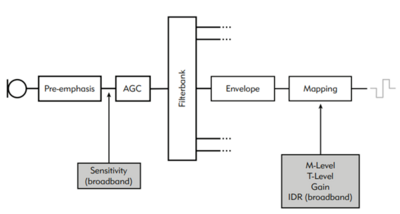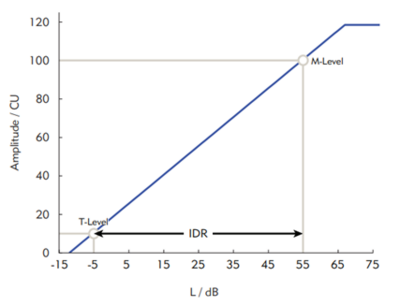Cochlear Implants
Introduction
A hearing aid with a cochlear implants translates incoming sound into electrical signals that are directly stimulating the nerves in the cochlea. The process of converting the sound waves into electrical current is done by a sound processor outside of the ear. The steps are the following:

- Microphone picks up sound
- ADC converts analog signal to digital signal
- Pre-filtering is applied for speech emphasis
- Automatic Gain Control (AGC) is applied
- Signal is split into frequency bands by a filter bank
- Hilbert Envelopes (amplitudes) are calculated per band
- Signal amplitudes per band are mapped to current amplitudes
- Current amplitudes per band are convoluted with spiking patterns
- Current steering distributes the current of a single band over multiple electrodes
- The resulting signals sent to the electrodes
Pre-emphasis filter

The pre-emphasis filter is meant to enhance speech recognition by lowering the weight of the lower frequencies in sound. As a consequence the loudness measured in dB of the sound after filtering will be lower than before the filtering. The loudness difference will depend on the exact shape of the filter as well as the spectral content of the sound. When presenting pink noise to the filter, as applied in AB devices, the overall loudness of the signal is diminished by about 10 dB, but, when presenting speech, the loudness will be less effected due to their different spectral content.
Automatic Gain Control
Fast and Slow averagers
Compression
See Dynamic_range_compression on wikipedia for more background info.
Band filtering
Hilbert Envelopes
Spike patterns
The mapping function

The mapping function translates the Hilbert Envelope Amplitudes for each channel to electrical signal amplitudes.
Different manufactorers use different mapping functions:
| Type of Mapping | Formula | Manufacturer |
|---|---|---|
| Logarithmic Mapping | I = G * log(L) + C | Advanced Bionics |
| Power Law Mapping | I = G * L^α + C | Cochlear |
| Linear Mapping | I = G * L + C | MED-EL |
G = proportionality factor or slope (sometimes confusingly called gain)
C = some constant
Sometimes different constant are used below and above the kneepoint.
Advanced Bionics Mapping Function
Following Advanced Bionics we can fill in some details of their mapping function:
I = ((M-T)/IDR) * (L - KNEE + IDR + GAIN) + T
where
- I is the electrical output in current units
- M is the most comfortable level in current units (CU)
- T is the threshold level in current units (CU)
- L is the loudness signal (Hilbert Envelope amplitude) in dB SPL
- KNEE is the kneepoint of the compression function in dB SPL
- IDR is the input dynamic range in dB SPL
- GAIN is the channel gain in dB SPL
N.B. Current units (CU) is defined differently by different manufacturers.
It follows from the equation that when L = KNEE - GAIN result in I = M, so the electrical output I is right at the M-Level. Since the GAIN is set to zero in most cases, the output is at the M-level when L = KNEE.
Terminology of Critical Points in the Mapping Function
In scientific literature, three key levels are recognized: 1. hearing threshold, 2. comfortable level, and 3. pain threshold, each denoted in various ways.
The following abbreviations are commonly used to describe specific levels of electrical stimulation:
- T, THR, or THL: These stand for Threshold Level, or Threshold Hearing Level. This is the lowest level of electrical stimulation that the user can perceive.
- M, MCL, or C: These abbreviations stand for Most Comfortable Level, Maximum Comfortable Level, or Comfortable Level. This level refers to the point at which sounds are comfortably perceived—neither too loud nor too soft.
- USL, MSL, UCL, or LDL: These stand for Upper Stimulus Level, Maximum Stimulation Level, Uncomfortable Loudness Level, or Loudness Discomfort Level. This level indicates the point at which sound becomes painful or uncomfortable for the user.
The terminology can vary depending on the manufacturer. For example, for the comfort level in clinical software:
- Advanced Bionics uses 'M-level',
- Cochlear uses 'C-level',
- Med-El uses 'MCL'.
There can also be some variation in the precise definitions of these terms.
The term "Maximum Comfortable Level" is less commonly used and can sometimes refer to the highest level that is still comfortable, just below the pain threshold. This usage can be confusing and should be avoided where possible.